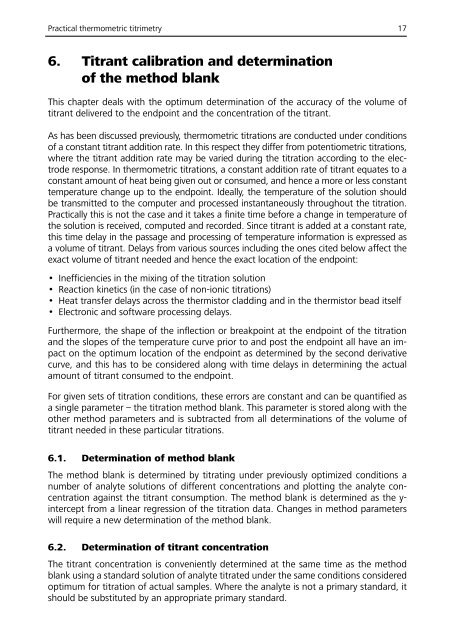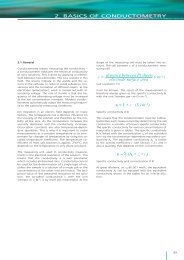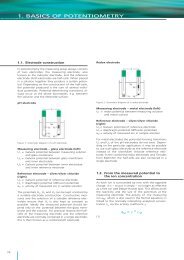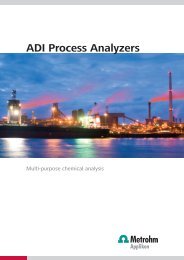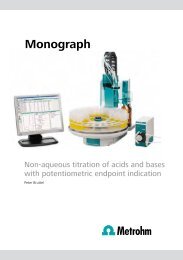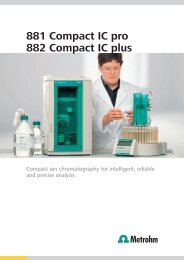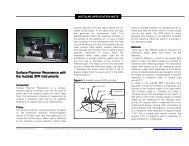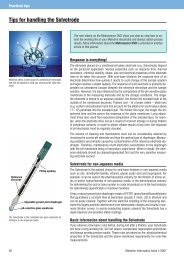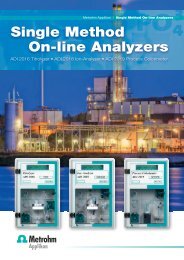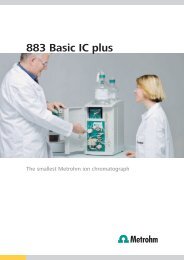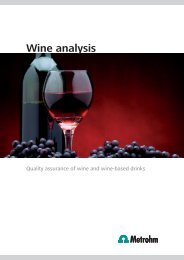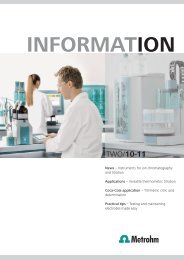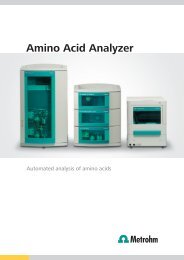Monograph - Metrohm
Monograph - Metrohm
Monograph - Metrohm
You also want an ePaper? Increase the reach of your titles
YUMPU automatically turns print PDFs into web optimized ePapers that Google loves.
Practical thermometric titrimetry 17<br />
6. Titrant calibration and determination<br />
of the method blank<br />
This chapter deals with the optimum determination of the accuracy of the volume of<br />
titrant delivered to the endpoint and the concentration of the titrant.<br />
As has been discussed previously, thermometric titrations are conducted under conditions<br />
of a constant titrant addition rate. In this respect they differ from potentiometric titrations,<br />
where the titrant addition rate may be varied during the titration according to the electrode<br />
response. In thermometric titrations, a constant addition rate of titrant equates to a<br />
constant amount of heat being given out or consumed, and hence a more or less constant<br />
temperature change up to the endpoint. Ideally, the temperature of the solution should<br />
be transmitted to the computer and processed instantaneously throughout the titration.<br />
Practically this is not the case and it takes a finite time before a change in temperature of<br />
the solution is received, computed and recorded. Since titrant is added at a constant rate,<br />
this time delay in the passage and processing of temperature information is expressed as<br />
a volume of titrant. Delays from various sources including the ones cited below affect the<br />
exact volume of titrant needed and hence the exact location of the endpoint:<br />
• Inefficiencies in the mixing of the titration solution<br />
• Reaction kinetics (in the case of non-ionic titrations)<br />
• Heat transfer delays across the thermistor cladding and in the thermistor bead itself<br />
• Electronic and software processing delays.<br />
Furthermore, the shape of the inflection or breakpoint at the endpoint of the titration<br />
and the slopes of the temperature curve prior to and post the endpoint all have an impact<br />
on the optimum location of the endpoint as determined by the second derivative<br />
curve, and this has to be considered along with time delays in determining the actual<br />
amount of titrant consumed to the endpoint.<br />
For given sets of titration conditions, these errors are constant and can be quantified as<br />
a single parameter – the titration method blank. This parameter is stored along with the<br />
other method parameters and is subtracted from all determinations of the volume of<br />
titrant needed in these particular titrations.<br />
6.1. Determination of method blank<br />
The method blank is determined by titrating under previously optimized conditions a<br />
number of analyte solutions of different concentrations and plotting the analyte concentration<br />
against the titrant consumption. The method blank is determined as the y-<br />
intercept from a linear regression of the titration data. Changes in method parameters<br />
will require a new determination of the method blank.<br />
6.2. Determination of titrant concentration<br />
The titrant concentration is conveniently determined at the same time as the method<br />
blank using a standard solution of analyte titrated under the same conditions considered<br />
optimum for titration of actual samples. Where the analyte is not a primary standard, it<br />
should be substituted by an appropriate primary standard.


